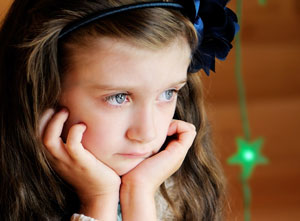Making Goodbyes Easier: A Parent’s Guide to Managing Separation Anxiety in Children
By: Rochelle Perper, Ph.D. | March 14, 2013

On Tuesday, March 19, Dr. Rochelle Perper was featured on the FOX5 San Diego morning segment entitled “ The Mommy and Daddy Handbook” to discuss separation anxiety in young children. You can see the video here. In tandem with the segment, Therapy Changes has released A Parent’s Guide to Managing Separation Anxiety in Children.
Tearful, tantrum-filled goodbyes are common during a child’s earliest years. Around the child’s first birthday, separation anxiety can develop when a parent leaves for the first time. Although separation anxiety is a perfectly normal part of childhood development, it can be unsettling for parents and caregivers. Understanding your child’s reactions and knowing a few coping strategies can help you and your child get through this difficult transitional time.
Understanding a Child’s Reaction
Stresses such as significant life change that results in a disruption to a child’s routine can trigger separation anxiety later in a child’s life. Probably one of the most significant transitions that occur in early childhood is a change in care situation, commonly attending preschool or kindergarten. Other changes can include a new sibling, moving to a new place, or tensions at home. The experience of separation anxiety lasts a variable amount of time, depending on the child and how a parent responds. In some cases, it can last through elementary school years, although typically it lasts only a few months.
During the early childhood stage of development, parents or caregivers are likely to experience a variety of intense, hard-to-understand emotions. On one hand, it can be gratifying to know that your child is as attached to you as you are to him or her. On the other hand, feelings of guilt can arise when you take time out for yourself and the amount of attention your child seems to require from you can seem overwhelming at times.
Positive Parenting Strategies
The following acronym, GRAPES will allow you to stay focused on what your child needs most:
- Goodbye ritual. Rituals are reassuring and can be as simple as a special wave through the window or a goodbye kiss.
- Routine. Keep familiar surroundings when possible and make new surroundings familiar.
- Acknowledge feelings. Try saying: “I know you feel sad and scared…”
- Practice Separation. Leave your child with a caregiver for brief periods and short distances at first.
- Enjoy your child’s accomplishments. Praise your child’s efforts – even the smallest.
- Swift goodbyes. Tell your child that you are leaving and that you will return and then go – don’t stall.
When to Call for Additional Help
Childhood, by nature is marked by certain fears – of monsters, of the dark, or being left with a new babysitter, of starting school, and so on. In early childhood, crying, tantrums or clinginess are healthy reactions to these fears. Separation Anxiety Disorder, however, is a more serious condition that requires additional support. “Separation Anxiety Disorder in children is the most common anxiety disorder,” Dr. Perper explains. “It is marked by extreme difficulty when away from home or loved ones. The disorder is marked by intense fear that the child’s parents or caregivers will be harmed when they are away from the home.” Therapy provided by professional therapists who specialize in children’s issues can be helpful to assist children in developing skills to overcome their fears and support families in learning positive parenting approaches to ease their child’s distress.
Those interested in learning more about separation anxiety in children are invited to download the Managing Separation Anxiety in Children resource. Be sure to tune into FOX5 San Diego segment on the morning of March 19. During the segment, Dr. Perper will discuss specific coping methods for separation anxiety. I hope to be able to help parents dealing with this common problem.



